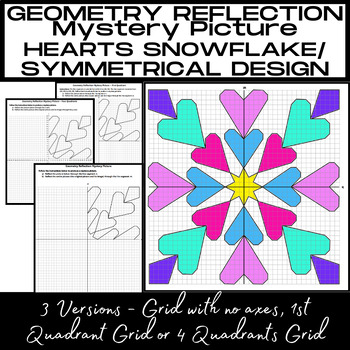REFLECTION Mystery Picture-HEARTS Symmetrical Design-Bulletin Board Art
- PDF
Also included in
- DescriptionThis bundle contains TWO resources, both producing the same snowflake/symmetrical design.Resource 1With the REFLECTION resource, students practice reflection through a line to produce a hearts snowflake or symmetrical design. This resource has three versions:Version A has a grid only andPrice $3.00Original Price $3.50Save $0.50
- This bundle contains 4 products. Please click on each product preview to see what each contains.Description of each product:With these resources, students practice reflection through a line to produce a snowflake or symmetrical design. Each resource has three versions:Version A has a grid only and nPrice $6.00Original Price $7.00Save $1.00
Description
Description
With this resource, students practice reflection through a line to produce a snowflake or symmetrical design. This resource has three versions:
- Version A has a grid only and no coordinate axes. It requires knowledge of reflection through a line segment.
- Version B requires understanding of plotted points in the first quadrant using positive whole numbers, as well as reflection through a line segment.
- Version C requires understanding of plotted points in all four quadrants using positive and negative whole numbers, as well as reflection through a line segment.
Enjoy using this resource with your students! Please leave feedback!
Tools Required
· Printed student instruction sheet (choose one version)
· Pencil
· Ruler
· Eraser
· Coloring pencils/markers
See preview for product contents.
There are lots of opportunities for coloring! This is a limited prep activity to reinforce reflection and coordinate graphing with a fun and engaging activity. It is ideal for whole class use, individual early finishers, homework, math center, substitution work, and homeschooling. The use of the grid without axes, as well as the first quadrant, and then all quadrants, assists differentiation and makes the resource appropriate for a number of grade levels.
These look great when all students' work is placed side-by-side to form a border on bulletin boards or to frame other work in wall displays.
Enjoy using this resource with your students! Please remember to leave feedback for TPT credits
and also leave pictures of your students' work!
You may also like:
- BUNDLE: COORDINATE GRAPHING & REFLECTION Mystery Pictures-Bulletin Board Geo Art
- Coordinate Geometry Reflection Mystery Picture-Snowflake/Symmetrical Design
- BUNDLE of 4 snowflakes/symmetrical designs
- Winter Snowflake (two versions - first quadrant & all quadrants)
- Winter Snowflake (two versions - first quadrant & all quadrants)
- Free Winter Snowflake (first quadrant)
- WINTER Coordinate Graphing Picture - ADORABLE OGRE
- Celebrate the New Year with this coordinate picture puzzle: HAPPY NEW YEAR 2024 Coordinate Graphing (Updated Yearly) - Plot Ordered Pairs







